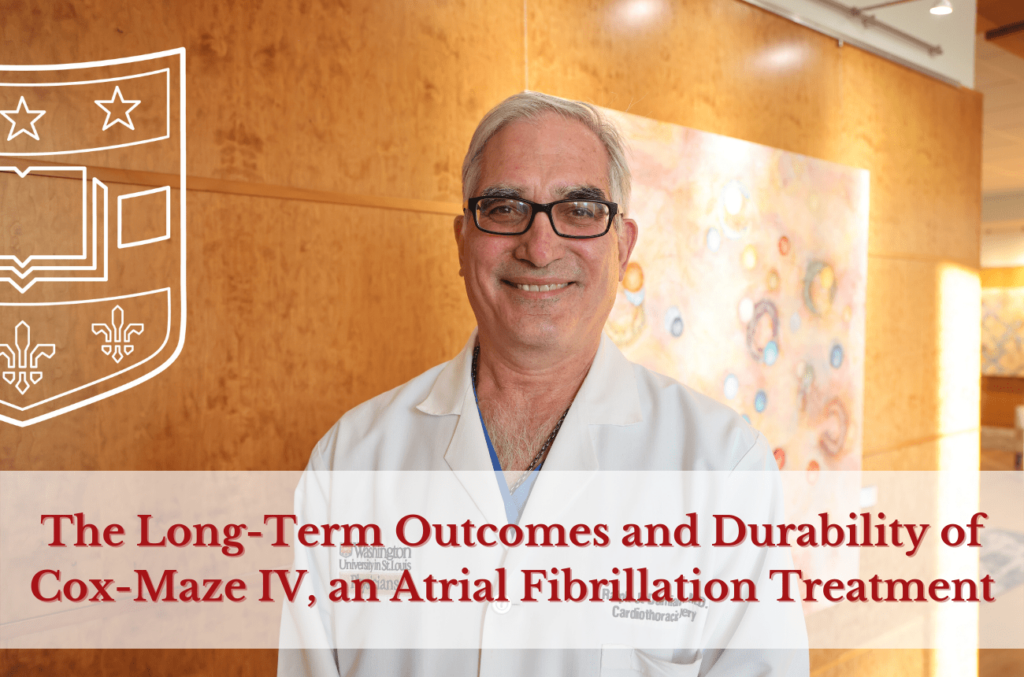Heart arrhythmia or irregular rhythms of the heart can be very life-threatening. Thirty years ago, research began in the Cardiac Surgery Arrhythmia Laboratory to learn how heart mechanisms contribute to but can also allow physicians to cure potentially life-threatening rhythm disturbances. Atrial fibrillation is the most common of these arrhythmias, and it has increased dramatically in the United States. Atrial fibrillation increases the occurrence of stroke and decreases life expectancy. Research and innovation by the Cardiac Surgical Research Laboratory at Washington University School of Medicine in St. Louis has helped develop new treatment methods, including the Cox-Maze procedure, to help reduce atrial fibrillation.
Reviewing the effectiveness of the Cox-Maze IV procedure, Washington University surgeons and researchers discovered there are significant long-term outcomes and durability to this treatment program. This research study demonstrates the effectiveness of the procedure in patients with life-threatening heart arrhythmia.
Background and Development
The Cox-Maze procedure was first developed and performed to treat atrial fibrillation in 1987 at Barnes Hospital. This was the first cure for atrial fibrillation, a heart arrhythmia condition. Contributions to the invention and innovation of this procedure were made by James Cox, MD, former division chief of cardiothoracic surgery, Richard Schuessler, PhD, former director of the Cardiac Surgical Research Laboratory, and late John Boineau, MD, professor of surgery, medicine and biomedical engineering. Current work on this procedure in its Cox-Maze IV form is now performed under the guidance of Ralph Damiano, Jr., MD, Evarts A. Graham Professor and Chief of Cardiothoracic Surgery, to address problems with cardiac arrhythmia and electrophysiology.
Decades ago, Schuessler and Boineau developed mapping and imaging technology to better understand what atrial fibrillation looked like in the heart. It took several iterations of research to understand what was happening in the heart, but Schuessler and Boineau deduced what occurred during atrial fibrillation and what specific areas of the heart were affected.
When the research group showed Cox their findings, his response was: “I can fix that.”
The treatment they developed, known as the Cox-Maze Procedure, involves a series of safe and effective incisions made to permanently block the electrical signals that are responsible for triggering the irregular heartbeat.
In 2000, Schuessler began a new phase of collaboration when Chief of Cardiothoracic Surgery Ralph J. Damiano, Jr., MD, the Evarts A. Graham Professor of Surgery and past research fellow with Cox, joined Washington University. With his arrival in the Department of Surgery, Cox’s mentor and two of his mentees were brought under one roof, and this group continued to innovate the Cox-Maze procedure for the next twenty years.
This team’s work led to the Cox-Maze IV procedure. This version is less invasive and more widely used as the gold standard for the surgical treatment of atrial fibrillation. It is also the only operation to receive an FDA indication for the treatment of atrial fibrillation. Measured outcomes, patients with atrial fibrillation who received the Cox-Maze Procedure were found to have a significantly higher survival rate.
“With the help of Dr. Schuessler’s insight and scientific prowess, we rigorously evaluated new ablation devices and developed a foundation for progress,” Damiano explains. “After extensive investigation, we developed an ablation lesion set that closely mirrored the cut and sew Cox Maze III procedure. We have shown that this procedure has had similar success rates with significantly lower morbidity and mortality.”
Research Question and Methods
The research project conducted by Washington University cardiothoracic surgeons, “The Long-Term Outcomes and Durability of the Cox-Maze IV Procedure for Atrial Fibrillation,” examined long-term patient outcomes following the Cox-Maze IV procedure (CMP-IV) as treatment for atrial fibrillation. This study is the largest series ever reported for the Cox-Maze IV procedure.
Between May 2003 and March 2018, 853 patients underwent a version of CMP-IV with complete isolation of the posterior left atrium. Among this group, the absence of atrial tachyarrhythmia (ATA) was assessed for up to 10 years. Rhythm outcomes were compared in multiple subgroups, and predictors of recurrence were determined to visualize death as the competing risk.
Results and Conclusions
In the research results, a majority of patients (60%) had nonparoxysmal atrial fibrillation, meaning the condition was persistent, longstanding-persistent, and permanent. Of these patients, 24% didn’t respond to at least 1 catheter-based ablation.
76% of patients were monitored during their follow-up. Freedom from ATA was 92%, 84%, and 77% at one, five, and 10 years, respectively. Through competing risk analysis, the project recognized an incidence of first ATA recurrence was 11%, 23%, and 35% at one, five, and 10 years, respectively. Statistical analysis demonstrated that there were several predictors of first ATA recurrence over 10 years of follow-up. These included age, peripheral vascular disease, nonparoxysmal atrial fibrillation, left atrial size, early postoperative ATAs, and absence of sinus rhythm at discharge.
Looking at the results of patient outcomes, the CMP-IV had an excellent long-term efficacy at maintaining sinus rhythm in the heart. At a later follow-up for patients with this treatment, the results of the CMP-IV remained superior to those reported for other procedures, like catheter ablation and other forms of surgical ablation for atrial fibrillation. Age, left atrial size, and nonparoxysmal AF were the most relevant predictors of late recurrence in patients who experienced it.
Washington University – Providing for Patients through Constant Innovation
Physicians and researchers at the Department of Surgery are continuing to improve their treatment programs to provide long-term health for patients with atrial fibrillation. Learn more about this procedure and how it can improve atrial fibrillation long-term.
Researchers:
Nadia H Bakir
Joshua L Manghelli
Laurie A Sinn
Hersh S Maniar
Spencer J Melby, MD
Article citation:
Khiabani AJ, MacGregor RM, Bakir NH, Manghelli JL, Sinn LA, Maniar HS, Moon MR, Schuessler RB, Melby SJ, Damiano RJ Jr. The long-term outcomes and durability of the Cox-Maze IV procedure for atrial fibrillation. Journal of Thoracic Cardiovascular Surgery. 2022 Feb; 163(2): 629-641.
